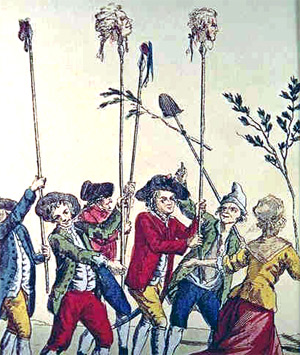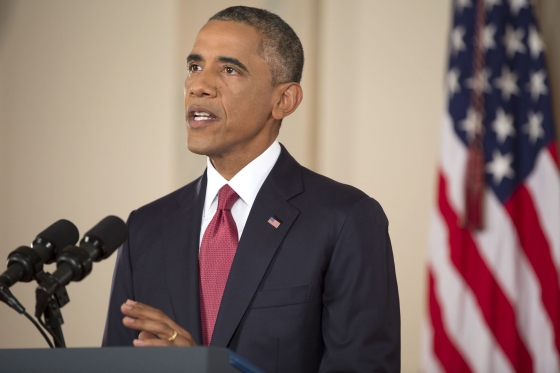There is a stunning lack of consensus in international policy circles and academia on a universally acceptable and comprehensive definition of terrorism. Although mixed statements out of Washington concerning the ongoing state of the international War on Terror leaves one rather un-stunned as even baffled Washington bureaucrats are themselves, at times, unsure as to what the state of the War on Terror is. What is terrorism, and is the infamous War on Terror still being waged? Facing a fast-approaching American election and a precariously balanced Middle East, the world looks on, following debates and unpacking sound bites to try to understand where this war might be headed.
[captionpix align=”left” theme=”elegant” width=”320″ imgsrc=”http://natoassociation.ca/wp-content/uploads/2012/10/HeadsOnPikes.jpg ” captiontext=”French revolutionaries parading the heads of French nobility during Robespierre’s Reign of Terror, the first modern terrorist.”]Terrorism is not a new form of violence. In the aftermath of the First World War, the League of Nations (1930) identified terrorism as a “criminal act directed against a state and intended or calculated to create a state of terror in the minds of particular persons, or a group of persons, or the general public.” Like the League itself, this convention failed to have much impact on the world stage. The problem with crafting a holistic definition of terrorism was and still is the inherently subjective nature of the act itself. Hence, the UN’s proposed Comprehensive Convention on International Terrorism has been deadlocked since 2002 over a stark difference in opinion as to what the convention should and should not include. The draft convention identifies “any person that intentionally causes death and/or public damage that may or may not result in economic loss, for the purposes of intimidating and/or compelling people, governments, or institutions to act or not act a certain way.”
Perhaps the biggest impediment to achieving consensus on this definition lies in the Organization of the Islamic Conference (OIC). While accepting the above definition, the OIC adamantly insists on it being qualified to exclude armed struggles against foreign occupation, aggression, colonialism, and hegemony aimed at liberation and self-determination. The current impasse in Syria tellingly illustrates the tension at play here. While the Assad regime insists on the terroristic nature of Syrian rebels, the Western majority fails to accept this characterization. In this stalemate, definitive action effectively grinds to a halt. Who is to say that a national liberation movement is not also a terrorist organization?
Terrorism as semantic, tact, and principle
As the Syrian impasse demonstrates, defining terrorism is hardly a matter of semantics for reasons of both tact and principle, although understanding terrorism in the benignly semantic sense does offer some interesting insight. Grammatically speaking, terror and terrorism are two different things. Whereas terror is a state of mind and terrorism an ideologically charged battle tactic, neither of the two can technically be considered a tangible enemy. For the United States, the emotively charged War on Terror represents a commitment to protecting Americans and perhaps even Westerners at large from the fear, trauma, and sense of insecurity that was collectively felt following 9/11. Conversely, the War on Terrorism represents an attack against an ideological system that supports terror as a means to achieving a given religiopolitical end. In this regard, the War on Terrorism represents a war of ideologies. This war is characterized by the tension between fanatically close-minded regimes that just so happen to be quantitatively (read: objectively) concentrated throughout the Middle East and the free and democratic governments of the West. This is a war of regime versus government. Dictator versus elected representative. Good versus evil.
[captionpix align=”right” theme=”elegant” width=”320″ imgsrc=”http://natoassociation.ca/wp-content/uploads/2012/10/Communism.jpg ” captiontext=”Meeting of the Congress of the Communist Party of the Soviet Union in Moscow, 1956. “]
Tactically, this war is as most analysts observe, unwinnable in a traditional militaristic sense. A standing military force can hit neither terror nor terrorism and surely there is no V.T. Day (as there was once a V.E. Day) on the foreseeable horizon. The end of the Cold-War system saw the disappearance of a definable and personified Other, which Americans and the democratic West might collectively identify and stand against. The ominous Soviet was indeed a tangible enemy and Communists were certainly found everywhere – even rumored to be dwelling in Hollywood. In this case, however, Communism had an ideological, political, and social center located in the Soviet Union.
The USSR was the geophysical embodiment of Communism whereas the current War on Terror tends to lack such qualities. If there ever was a tangible enemy in the War on Terror, he was Osama bin Laden, but I do believe that it would be naive at best to think that killing bin Laden signals the end of the War on Terror. This war, winnable or not, rather represents a fundamental shift in Western strategic thought and a greater evolution in the nature of modern warfare. As mentioned above, this is a war of systemic proportions and will, therefore, carry on – in one form or another – into the prolonged future.
Legally, appending a definition to terrorism is a matter of necessity insofar as placing it in the international legal discourse is concerned. There is always a measure of exactitude required by codified law in defining any proscribed act, including terrorism. Criminalizing terrorist acts requires a concerted acceptance by international legal institutions of a definition as well as the subsequent adoption by national legislative bodies. The purpose of criminalizing terrorism is three fold: to declare that the conduct is forbidden, to prevent it, and to express society’s moral condemnation of such acts. In so doing, the immediate implications are found in the reduced cost of prosecuting international terrorists with the long term objective of hopefully deterring terrorism. However, the international legal principle of nullum crimen sine lege (no crime without law) requires that a society define the prohibited act before anyone can be prosecuted for committing the act. That being so, the international legal community – as an amalgam of many national legal jurisdictions – requires a precise definition of terrorism so that national bodies may adopt and employ the definition while prosecuting and possibly serving to extradite perpetrators to their home nation.
Politics of Terrorism
By most accounts, President Bush’s War on Terror stands as the second of such wars in a succession that began with the Reagan administration’s declaration of “war against terrorism” in reaction to the 1983 Beirut Barracks Bombing. Under both the Reagan and Bush administrations, the argument could be made that terrorist cells were loosely organized as appendages of rogue state-apparatuses. In both cases, Washington had an identifiable target and a Clausewitzian “centre of gravity” towards which it could take aim and fire. In the immediate post-2001 environment tactical centers of gravity were located in Kandahar and (to some extent) Baghdad. However, over the past half-decade there has been a qualitative shift in the tone and texture of this ongoing war, leading many to wonder whether it is even still ongoing at all.
Despite the drastic difference in approach to combating the War on Terror, President Obama has nevertheless maintained America’s commitment to defending against an ever-present and looming threat to the American way of life. The past four years of the Obama administration have arguably witnessed the subsumption of the Bush-cum-counter-terror foreign policy framework to a supposedly more morally upright foreign policy. Elected on the commitment to dial down the War on Terror, President Obama promised the American electorate a war that was morally acceptable and overall more effective – smatter, better, nimbler, stronger.
Whereas under the Bush Administration, the manifestations of the War on Terror were plainly visible (IEDs and body bags, torture hearings, and bin Laden’s no.1 placeholder on the FBI most wanted list) they have become less so since 2008. Among other things, Obama promised the closure of Guantanamo Bay, the withdrawal from Iraq, and the capture of bin Laden. Signing the executive order to close Guantanamo was paramount on his list of things to do upon receiving office although President Obama has since failed to maintain this commitment, as Guantanamo still operates and holds detainees outside the transparent international legal and human rights frameworks. The mission in Iraq has been dialed down and American military efforts have been accordingly refocused in Afghanistan, which most in the White House view as the front line in the War on Terror.
[captionpix align=”right” theme=”elegant” width=”320″ imgsrc=”http://natoassociation.ca/wp-content/uploads/2012/10/drone.jpg ” captiontext=”The Reaper drone. “]
The nature by which the Afghan mission is being carried out under the Obama administration highlights an issue of central importance here. The use of unmanned aerial drones and targeted killings sums up the direction of the War on Terror in the United States – now and into the future – irregardless of the outcome of November’s presidential election. Unmanned drone killings are quick, decisive, and occur on what seems to be the murky underbelly of international law and diplomacy. Are they legal? The legal debate still continues, as some have even leveled war-crimes charges against the Obama administration. President Obama has indeed mastered the art of striking a balance between maintaining a minimal public awareness of American counter-terrorist operations while meeting the pressing need for decisive and effective action in this war of systemic proportions. Whether Obama assumes an additional four years or Republican Candidate Mitt Romney takes the Oval Office, I do believe that the Obama Administration has found a formula that works and this formula will frame American counter-terrorist policy for the years to come.




